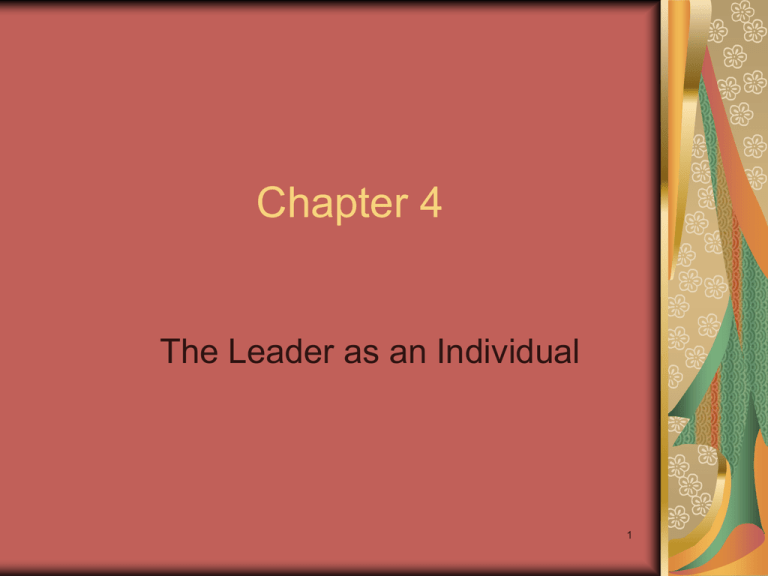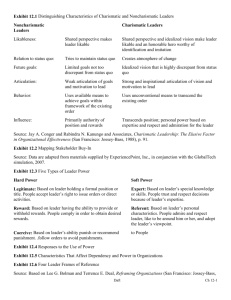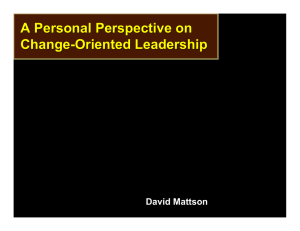Slides: CHAPTER 4
advertisement

Chapter 4 The Leader as an Individual 1 Chapter Objectives Identify major personality dimensions and understand how personality influences leadership and relationships within organizations. Clarify your instrumental and end values, and recognize how values guide thoughts and behavior. Define attitudes and explain their relationship to leader behavior. Recognize individual differences in cognitive style and broaden your own thinking style to expand leadership potential. 2 Chapter Objectives (contd.) Practice aspects of charismatic leadership by pursuing a vision or idea that you care deeply about and want to share with others. Apply the concepts that distinguish transformational from transactional leadership. 3 Personality The set of unseen characteristics and processes that underlie a relatively stable pattern of behavior in response to ideas, objects, and people in the environment 4 Ex. 4.1 The Big Five Personality Dimensions Quiet, withdrawn, unassertive Low Extroversion High Outgoing, energetic, gregarious Warm, considerate, good-natured Aloof, easily irritated Low Agreeableness High Impulsive, carefree Low Conscientiousness High Moody, tense, lower selfconfidence Narrow field of interests, likes the triedand-true Low Low Emotional Stability Openness to Experience High High Responsible, dependable , goal-oriented Stable, confident Imaginative, curious, open to new ideas 5 Personality Traits Locus of Control Defines whether a person places the primary responsibility for what happens to him or her within himself/herself or on outside forces Authoritarianism The belief that power and status differences should exist in an organization 6 Values Fundamental beliefs that an individual considers to be important, that are relatively stable over time, and that have an impact on attitudes and behavior. End Values Sometimes called terminal values, these are beliefs about the kind of goals or outcomes that are worth trying to pursue. Instrumental Values Beliefs about the types of behavior that are appropriate for reaching goals. 7 Attitude An evaluation (either positive or negative) about people, events, or things. Self-Concept The collection of attitudes we have about ourselves; includes self-esteem and whether a person generally has a positive or negative feeling about him/herself. 8 Theory X and Theory Y Theory X: the assumption that people are basically lazy and not motivated to work and that they have a natural tendency to avoid responsibility Theory Y: the assumption that people do not inherently dislike work and will commit themselves willingly to work that they care about 9 Cognitive Style How a person perceives, processes, interprets, and uses information 10 Ex. 4.4 Hermann’s Whole Brain Model A Upper left B Lower left Logical Analytical Fact-based Quantitative Organized Sequential Planned Detailed Holistic Intuitive Integrating Synthesizing Interpersonal Feeling-based Kinesthetic Emotional D Upper right C Lower right 11 Myers-Briggs Type Indicator (MBTI) Personality test that measures how individuals differ in gathering and evaluating information for solving problems and making decisions 12 Ex. 4.5 Distinguishing Characteristics of Charismatic and Noncharismatic Leaders Noncharismatic Leaders Charismatic Leaders Likableness Shared perspective makes leader likable Shared perspective and idealized vision make leader likable and an honorable hero worthy of identification and imitation Trustworthiness Disinterested advocacy in persuasion attempts Passionate advocacy by incurring great personal risk and cost Relation to status quo Tries to maintain status quo Creates atmosphere of change Future goals Limited goals not too discrepant from status quo Idealized vision that is highly discrepant from status quo 13 Ex. 4.5 (contd.) Noncharismatic Leaders Charismatic Leaders Articulation Weak articulation of goals and motivation to lead Strong and inspirational articulation of vision and motivation to lead Competence Uses available means to Uses conventional achieve goals within means to transcend the framework of the existing existing order order Behavior Conventional, conform to norms Unconventional, counternormative Influence Primarily authority of position and rewards Transcends position; personal power based on expertise and respect and admiration for the leader 14 Transactional versus Transformational Leadership Transactional leadership a transaction or exchange process between leaders and followers Transformational Leadership leadership characterized by the ability to bring about significant change in followers and the organization 15



